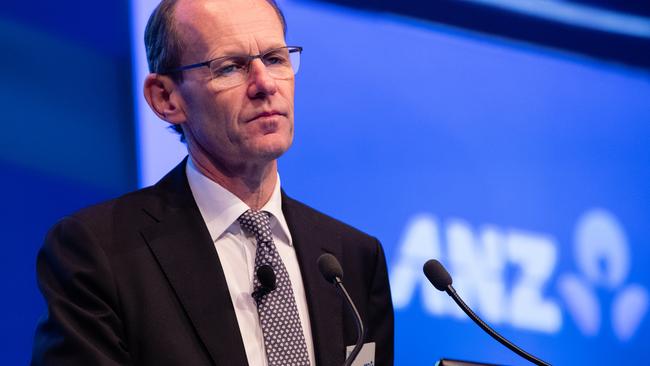ANZ posts rise in half-year cash profit but warns of challenges ahead
ANZ has raised first-half cash profit to a better-than-expected $3.56bn, but flagged tougher times ahead.

ANZ has delivered a better-than-expected lift in first-half cash profit to $3.56 billion, although the bank warned of a “number of headwinds” facing the sector including a slump in demand for mortgages.
ANZ’s cash profit from continuing operations edged up 2 per cent to $3.56 billion in the six months ended March 31, from the same period a year earlier, an ASX statement said today. Including discontinued operations, the result climbed 22 per cent to $3.5 billion.
Analysts were expecting a first-half cash profit of $3.48 billion.
The result was buoyed by cost cutting and an 8 per cent jump in revenue in ANZ’s institutional division, while the Australian unit saw revenue decline 6 per cent.
At 1pm (AEST) ANZ shares were up 3.1 per cent at $28.04.
ANZ chief executive Shayne Elliott warned of a challenging outlook for the banking sector as demand for home loans had “slowed significantly”.
“Retail banking in Australia will remain under pressure for the foreseeable future with subdued credit growth, intense competition and increased compliance costs impacting earnings,” he said. “While our performance this half was solid there are headwinds facing the sector and we are taking appropriate action.”
The bank’s full-time employee numbers dropped 5 per cent to 39,400 in the half and the bank reduced “absolute costs” by more than $300 million, the results announcement showed.
ANZ also said $928 million in remediation charges had been booked since the first half of 2017, as the fallout from the Hayne royal commission continues.
The Melbourne-based bank declared an interim dividend of 80 cents per share, fully franked, steady on a year earlier.
ANZ’s net interest margin - the interest banks earn on loans less the cost of funding them - fell 2 basis points in the half to 1.8 per cent from the prior six months.
Excluding customer remediation and markets balance sheet activity the net interest margin was flat on the prior half.
ANZ didn’t announce any further capital management measures after completing a $3 billion share buyback this year.
Its common equity tier one capital ratio increased to 11.5 per cent, up 45 basis points.
That is well above the banking regulator’s “unquestionably strong” requirement, but mooted changes in New Zealand to boost capital requirements have heightened uncertainty over the capital buffers of Australian banks that dominate the NZ market.
ANZ - which has the biggest exposure among its peers to NZ - said the overall impact of the capital measures would depend on “a number of factors”. Those include the outcome of a consultation period on the capital requirements and how the banking regulator in Australia outlined regulatory changes in this market.
Return on equity rose to 12 per cent.
Credit Suisse analysts, led by Jarrod Martin, didn’t see many positives in ANZ’s results.
“On an underlying basis ANZ’s profit growth has stalled with flat revenue growth across the half only offset by lower expenses,” he said in a note to clients.
“With non-existent balance sheet growth, urgency on costs will be required.”
Morgan Stanley analyst Richard Wiles was just as sombre.
“Capital remains strong, but no further buybacks were announced and underlying earnings trends are weaker than expected,” he said.




